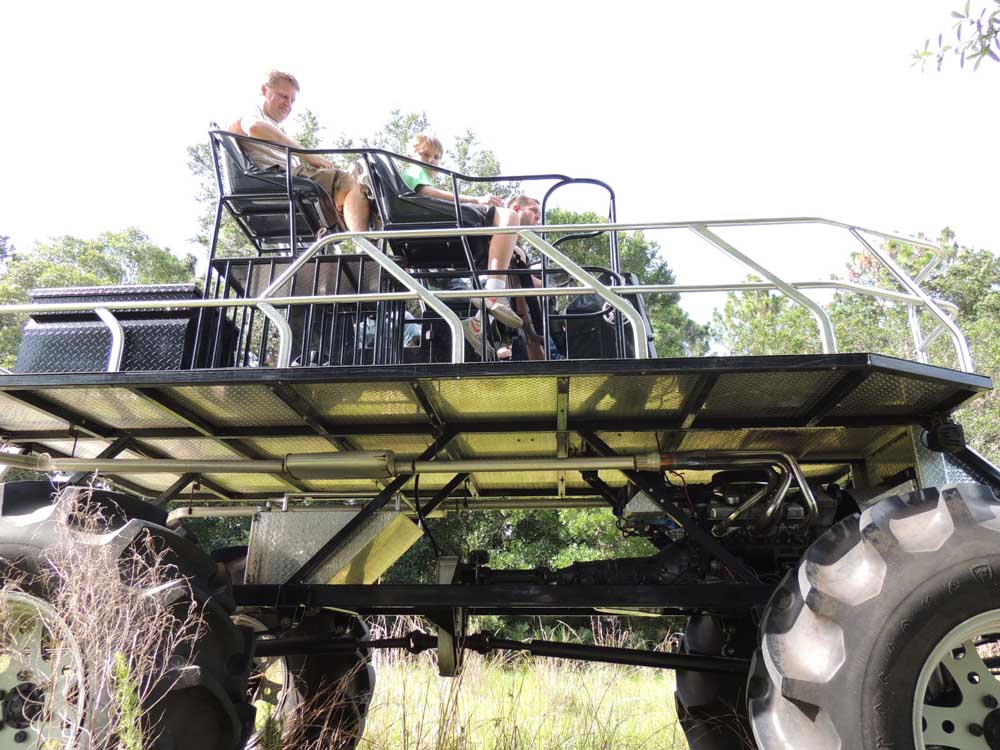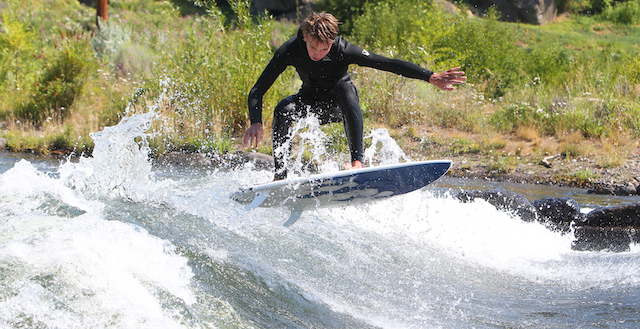Hunting wild boar in Florida
Published 12:00 am Wednesday, June 24, 2015

- Gary Lewis / For The BulletinHunting feral hogs in Central Florida, Matthew McFarland, his son Chisel and Grayson Padrick take their seats in Padrick’s swamp buggy.
We waited as the sun marched toward the Florida skyline. I held my hand out at arm’s length. The sun was two fingers above the tops of the trees. Twenty minutes left.
More of the nasty little biting ants. They’d bitten me 40 times already. They had not bothered Mikayla.
In the double ladder stand we were 6 feet off the ground. We had wind at the back of our necks all afternoon. There is always a chance a hog will show up anyway, one that has lost its sense of smell… I didn’t hold out a lot of hope we’d see pigs. Bad luck.
In mid-June, Florida’s grass was green and as tall as a half-grown calf. We were in cattle lands with patches of spiky, Central Florida jungle in a flat pasture. Swamp smells, bird calls and insect chirps filled the late afternoon. All foreign, except the waiting.
We expected the hogs, if any, to emerge from the jungle to our right, but then, when the pasture was in full shadow, a long line of pigs emerged on a trail on our left, from the only area they might have not winded us.
A steady breeze had deposited our scent spores on grass blades for the last three hours, and when the smaller pigs hit it, they hesitated, then charged ahead. At the back of the line came two larger sows, then two boars larger still. The sows came on behind the half-grown pigs; the two bigger animals halted, looked our way and grunted, then started to turn.
We couldn’t get the two biggest ones in both our scopes at the same time and I wouldn’t shoot until Mikayla fired. Now they were out of sight, although we could hear them grunt their displeasure. We focused on the swine in front of us.
They were in constant motion. The biggest was broadside for a moment, then it faced straight away, sometimes screened by other pigs. Then it was broadside again.
Mikayla whispered, “Ready,” flicked the safety to “fire” and squeezed. After the shot, she slammed another Ballistic Tip into the chamber of her Ruger. When the other pigs cleared out, we climbed down from the stand and walked over to get a look at her first feral hog.
It was a dry sow, perhaps 100 pounds, one of the best animals she could have shot, both for the abundance of meat, its flavor and its quality.
Not too many minutes later, we heard shots from the northeast and knew Matthew McFarland and his boys had bagged hogs as well.
We were hunting with Grayson Padrick, who owns Central Florida Trophy Hunts. He does not at present guide for wild boar, although he may again in the future. This was just a quick hunt to show off his hand-built buggy.
Powered by a well-muffled 350 Chevrolet, its floorboards are almost 7 feet off the ground and it seats four passengers and a driver. A landing, halfway to the deck, allows for stowage of rifle cases, coolers and alligators, pigs or deer. They sure do things different in Florida.
In the last few years, there has been an increased interest among Oregonians in hunting hogs. There are hogs here, and like everywhere on this continent, they are an invasive species. Some states treat them like game animals, and they have proliferated, displacing deer, wiping out songbirds and quail and destroying habitat.
In Oregon, the Department of Fish and Wildlife treats them as feral. To discourage landowners from giving swine a foothold here, the profit motive has been taken away. Outfitters and landowners are not permitted to charge fees for hunting hogs. Still, there are hogs and rumors of hogs in north Central Oregon and in southwest Oregon’s Siskiyous.
Cash-strapped California charges exorbitant fees to out-of-state hunters and seems to raise the tag prices every couple of years. Outfitters charge rates that run $700 to $1,500 per hunter for two- and three-day hunts. On private lands, success is high, because the feral hog is now the state’s No. 1 big-game animal.
In Texas, where some areas are overrun, landowners and outfitters encourage hunters to shoot as many as they can — day or night. Outfitted hog hunts run from $150 per day and up. Hire a helicopter and the price skyrockets.
I’ve hunted Polynesian boar in Hawaii, and they are one of the toughest of the islands’ game animals to put in a cooler. Plan to spend $1,000 for a one-day trophy hunt.
Florida might offer the lowest-priced hog hunting I’ve found. According to Padrick, prices range from $150 to $500 for a feral hog hunt.
We finished with five hogs for our evening hunt. The last two fell to 150-grain AccuBonds from my bolt-action. Hog hunting can return a lot of sport and meat for a day or two in the field. We’re shipping home pork loin, chops and links, and as much fun as it is, I hope I never see another feral hog in Oregon. I’d rather travel to hunt them.
— Gary Lewis is the host of “Frontier Unlimited TV” and author of “John Nosler — Going Ballistic,” “A Bear Hunter’s Guide to the Universe,” “Hunting Oregon” and other titles. Contact Lewis at www.GaryLewisOutdoors.com.







